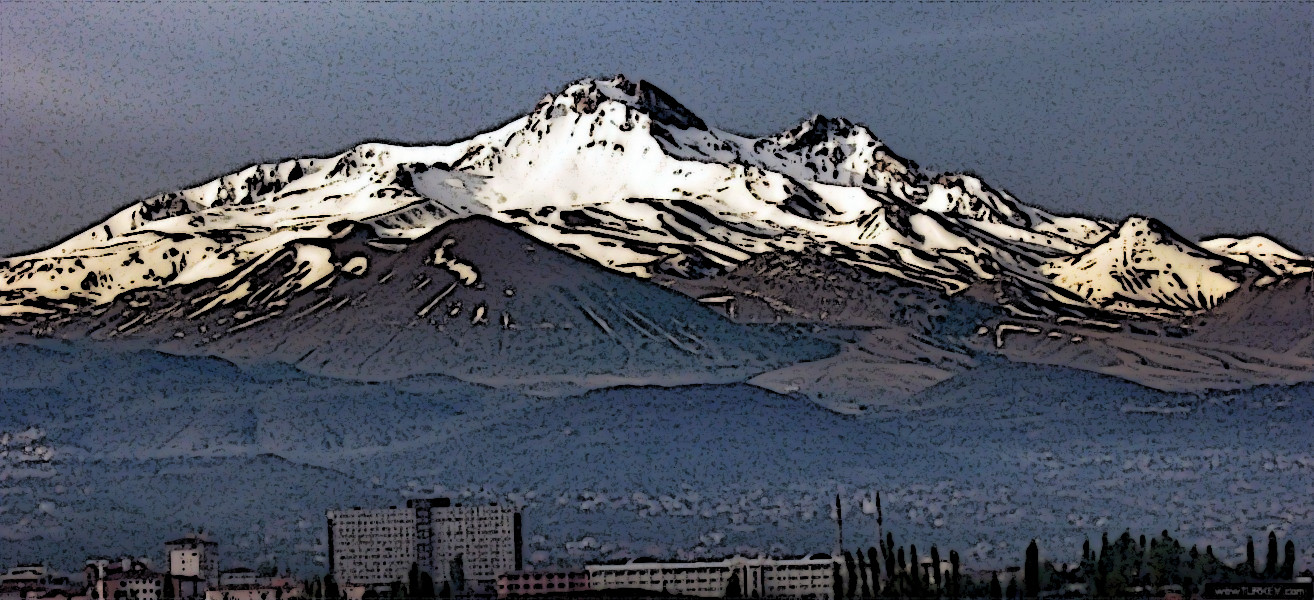Mount Erciyes

Mount Erciyes (Turkish: Erciyes Dağı; Latin: Argaeus; both from Ancient Greek: Ἀργαῖος Argaeos) is a massive stratovolcano located 25 km (16 mi) to the south of Kayseri in Turkey.
Erciyes is the highest mountain in central Anatolia, located within the ancient region of Cappadocia, with its summit reaching 3,916 m (12,848 ft). It is considered to be the highest peak of the Anti-Taurus mountain range, a northeastern extension of the Taurus Mountains to the south, and belongs to the Alpide belt in Eurasia.
The volcano is heavily eroded, but may have erupted as recently as 253 BC, as may be depicted on Roman era coins.
Strabo called the mountain Argaeus (Ἀργαῖος); he wrote that the summit was never free from snow and that those few who ascended it reported seeing both the Black Sea to the north and the Mediterranean Sea to the south in days with a clear sky.
The first documented successful climb was performed by William John Hamilton in 1837. There are, however, some historic writings and symbols on the rocks at the summit, indicating earlier human presence there. There are two caves near the summit tower, of which at least one must have been expanded by humans. It is supposed that monks in historic times have visited the summit several times.
There are winter sports facilities on the mountain, usually accessed from nearby Kayseri.
Medieval Introduction
Erciyes, also called Argaeus, is a mountain stronghold in central Cappadocia which served as a base for clan Cappadocian and was abandoned after the Giovanni took over the clan. It was sometimes called the "Monastery of Shadows" due to its location: the high cliffs on all sides meant it received only a few hours of direct sunlight each day.
Cainite History
Erciyes was taken over by the Cappadocians in a mass assault (the only military action in the history of the clan) sometime in the 1st century BC, when they replaced a mountain monastery originally serving as a cult for a Malkavian Osiris. Since that time, the clan supported a temple complex at the mountain dedicated to the Cappadocian study of death and God. This temple was Christian (as Cappadocians tended to be), but was known for its strange and horrifying secrets.
After the Feast of Folly, Cappadocius relocated to Erciyes, and spent the remainder of his unlife in and around the temple complex. In the year 1197, unknown parties guided the visiting Giovanni monk Niccolo Giovanni to the Noddist scrolls that came to be known as The Erciyes Fragments. Niccolo subsequently vanished, and his possessions (including his journal, which transcribed the Fragments) were delivered to his family.
When Augustus Giovanni committed diablerie on Cappadocius, the temple was sacked by his troops and abandoned.
Notes
While Erciyes is intimately associated with the Cappadocians, it was one of several underground cave complexes used by the clan, the other notable ones being Kaymakli and Derinkuyu.
References
- Clanbook: Cappadocian
- Clanbook: Giovanni Revised